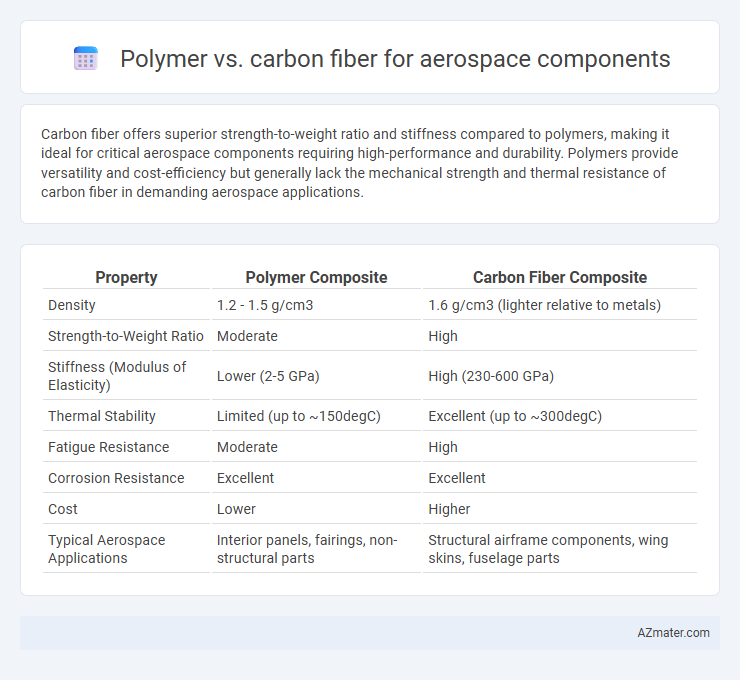Carbon fiber offers superior strength-to-weight ratio and stiffness compared to polymers, making it ideal for critical aerospace components requiring high-performance and durability. Polymers provide versatility and cost-efficiency but generally lack the mechanical strength and thermal resistance of carbon fiber in demanding aerospace applications.
Table of Comparison
| Property | Polymer Composite | Carbon Fiber Composite |
|---|---|---|
| Density | 1.2 - 1.5 g/cm3 | 1.6 g/cm3 (lighter relative to metals) |
| Strength-to-Weight Ratio | Moderate | High |
| Stiffness (Modulus of Elasticity) | Lower (2-5 GPa) | High (230-600 GPa) |
| Thermal Stability | Limited (up to ~150degC) | Excellent (up to ~300degC) |
| Fatigue Resistance | Moderate | High |
| Corrosion Resistance | Excellent | Excellent |
| Cost | Lower | Higher |
| Typical Aerospace Applications | Interior panels, fairings, non-structural parts | Structural airframe components, wing skins, fuselage parts |
Introduction to Aerospace Materials
Polymer composites and carbon fiber materials are critical in aerospace component manufacturing due to their high strength-to-weight ratios and durability under extreme conditions. Carbon fiber excels in stiffness and thermal resistance, making it ideal for structural parts subjected to high stress, while polymers offer design flexibility and cost efficiency for non-load-bearing components. Advanced aerospace materials increasingly combine these properties to optimize performance, reduce weight, and enhance fuel efficiency in aircraft and spacecraft applications.
Key Properties: Polymer vs Carbon Fiber
Carbon fiber exhibits superior tensile strength, stiffness, and thermal resistance compared to polymers, making it ideal for aerospace components requiring high performance under extreme conditions. Polymers offer advantages in weight reduction and corrosion resistance but generally lack the mechanical strength and stiffness provided by carbon fiber composites. The anisotropic nature of carbon fiber allows tailored load-bearing characteristics, while polymers provide more flexibility and ease of manufacturing for non-structural aerospace parts.
Weight and Strength Comparison
Carbon fiber exhibits superior strength-to-weight ratio compared to traditional polymers, making it ideal for aerospace components where minimizing mass is crucial. Polymers generally possess lower tensile strength and stiffness, resulting in heavier structures to meet strength requirements. The significant reduction in component weight achieved with carbon fiber enhances fuel efficiency and overall aircraft performance.
Durability and Fatigue Resistance
Carbon fiber composites offer superior durability and fatigue resistance compared to traditional polymers, making them ideal for aerospace components subjected to high stress and cyclic loading. Their high tensile strength and stiffness maintain structural integrity over prolonged use, significantly reducing maintenance and replacement costs. Polymers, while lightweight and corrosion-resistant, generally exhibit lower fatigue endurance, limiting their application in critical aerospace parts.
Thermal and Chemical Stability
Carbon fiber composites exhibit superior thermal stability with high resistance to heat and excellent dimensional integrity at elevated temperatures compared to polymer-based materials. Their enhanced chemical resistance makes them ideal for aerospace components exposed to harsh environmental conditions, including fuels and oxidizing agents. Polymers, while lightweight and cost-effective, generally demonstrate lower thermal thresholds and are more susceptible to chemical degradation, limiting their use in high-performance aerospace applications.
Manufacturing Processes and Costs
Polymer composites offer lower manufacturing costs due to simpler molding processes like injection molding and shorter cycle times, making them suitable for high-volume aerospace components. Carbon fiber components require energy-intensive autoclave curing and precise layup techniques, leading to higher labor and equipment expenses but superior strength-to-weight ratios. The choice depends on balancing budget constraints with performance requirements, as carbon fiber's expensive manufacturing delivers enhanced mechanical properties critical for aerospace applications.
Design Flexibility and Applications
Polymer composites offer exceptional design flexibility for aerospace components, enabling complex shapes and lightweight structures through versatile molding processes. Carbon fiber composites provide superior strength-to-weight ratios and stiffness, making them ideal for high-performance applications like aircraft fuselages and wings. The choice between polymers and carbon fiber depends on the specific aerodynamic, structural, and weight requirements of aerospace designs.
Environmental Impact and Sustainability
Carbon fiber composites offer high strength-to-weight ratios crucial for aerospace, but their production involves energy-intensive processes and challenges in recycling, leading to significant environmental impact. Polymer composites, especially biobased polymers, present opportunities for reduced carbon footprints and enhanced recyclability, promoting sustainability in aerospace applications. Advances in bio-resins and improved end-of-life treatment methods are increasingly making polymer composites viable eco-friendly alternatives to traditional carbon fiber components.
Real-World Case Studies in Aerospace
Carbon fiber composites demonstrate superior strength-to-weight ratios and fatigue resistance compared to traditional polymers, making them the preferred material in aerospace components like fuselage sections and wing structures. Real-world case studies, such as the Boeing 787 Dreamliner, reveal carbon fiber's ability to reduce overall aircraft weight by approximately 20%, leading to significant fuel efficiency gains. Meanwhile, polymer composites are often used in non-structural aerospace applications due to their cost-effectiveness and ease of manufacture despite lower mechanical performance.
Future Trends in Aerospace Material Selection
Future trends in aerospace material selection emphasize the increasing adoption of carbon fiber composites due to their superior strength-to-weight ratio and enhanced fatigue resistance compared to traditional polymers. Advanced manufacturing techniques like automated fiber placement and additive manufacturing are accelerating the integration of carbon fiber in critical aerospace components, optimizing performance and fuel efficiency. Research into hybrid materials combining polymers and carbon fibers aims to balance cost, durability, and weight, driving innovation in next-generation aerospace structures.

Infographic: Polymer vs Carbon fiber for Aerospace component
 azmater.com
azmater.com